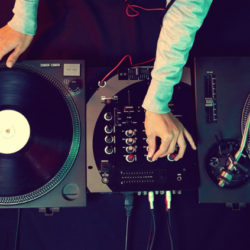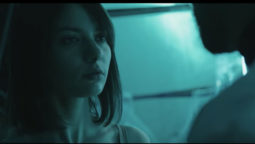Blending is a fundamental skill for a DJ. In its fully fleshed-out form, it’s been the basis of my style from day one. I started DJing because I loved the concept of making an extended musical chain link that takes you from place to place, from genre to genre, in a non-stop fashion. You can see it in my first set of mix tapes titles: The Blend Result, From Beginning to Blend, The Blend Of The Road, All Good Things Must Come To A Blend, etc. and continues to shine through in my present day approach.
In essence, blending keeps the mix of music continuous. Without any consideration for the notes involved, it can simply be called “beat matching,” which is the practice of using two or more turntables or CD players and a mixer’s horizontal crossfader (and/or individual channel faders) to blend two or more recorded sounds. It is done by adjusting the pitch of an upcoming track to match the currently spinning track, while maintaining a constant beat and somewhat quickly transitioning from one to the next. Blending, however, goes a step further by maintaining that mixture over a longer period of time–sometimes a song’s full length. It involves actually re-mixing tracks in a way that may not be the original intention of the artist (i.e., taking the vocal/acapella of one track and overlapping it with the beat of a completely different track), which can create new and unique versions of pre-existing songs: i.e. remixing on the fly, or a live blend, or the a live-remix.
In The Beginning There Was Kid Capri…
When I started out DJing, everything was New York-centric, as it was the birthplace & Mecca of hip-hop culture where the worldwide audience got their cues from (BIG pun intended). In the fall of 1989, mixtape legend Kid Capri hit Harlem and the mixtape circuit with what would become one of the most definitive blends in history. He floated Stephanie Mills’ “Something In The Way You Make Me Feel” acapella through its first verse & chorus, to cut in & blend The Honeydrippers’ “Impeach The President” drum breakbeat underneath it. It pretty much birthed the “hip-hop/soul” genre Mary J. Blige became the queen of.
It immediately married R&B’s melodic emotion to the raw street energy of the very breakbeat that would become the backbone of hip-hop production of the day. What it didn’t display, is the natural magic of harmony. Harmony ultimately makes a blend even more potent; whether it be an acapella, or the full version of a song harmonizing over the melody of a completely unrelated instrumental. From that point forward, New York DJs blazed a trail of being oblivious or indifferent to harmony, often putting out mixtapes & party records full of off-key blends. These made me cringe and a little bit upset that they were being celebrated. I chose to blaze a different trail.
The Lost Art
Let me be clear when I say that blending is a talent and it’s not one that every DJ prioritizes or possesses. With the addition of plug-ins like the sync button and “mix-in-key,” and programs like Ableton Live & Pro Tools, blending’s relevance has been called into question quite a bit over the past few years. The most recent example of this was made by controller-based DJ setup Virtual DJ’s mission statement:
“At VirtualDJ, we believe that nobody cares if you know how to beat match tracks in 1 second or 1 minute, that is not what makes you a better DJ. Your audience will never notice anyway. But what you play and how you play it, is what is important. Based on that, we don’t mind relegating the technical side of the mix to the machine, and help you focus on the creative and artistic side of your skills. Our goal is to help you mix better, not to preserve the legacy of the DJing culture at all costs, so we are not afraid to break the rules and do things differently, if we feel it would improve your performance in the long run. And history have shown again and again that every change we implemented, no matter how frowned upon by the DJ establishment at the beginning, always ended up becoming the norm a few years later.”
What the fine folks at Virtual DJ fail to realize is that… nevermind. They can really simply go to Hell.
My weapon of choice is the turntable and for pulling off a live blend, beat matching skill, as well as the attention span to oversee and constantly adjust the speed/pitch of the acapella over the new instrumental, is crucial. Some of my first blends in the early Nineties used acapellas of female R&B talents like Brandy & the aforementioned Mary J. Blige over the likes of Pete Rock & The Beatminerz instrumentals. As R&B aligned itself more and more with hip hop, their construction became the same [ex: 8-bar intro, 16-bar verse, 8-bar chorus, 16-bar verse, 8-bar chorus, possible bridge or vamp after second chorus, 16-bar verse, 8-bar chorus, outro]. This has made live blends “lock up” from front to back for many songs, so all you had to do was cut the acapella in on time (and on beat), maintain its speed throughout, creatively stop it or fade it out before the beat ended and quickly beat match and blend in the next song.
Some Considerations
As for how I choose what to blend, there’s truly no method to the madness. I do try not to tweak either source, acapella or instrumental, too far away from their normal pitches, which means I usually mess with songs that are close to each other BPM-wise. I sometimes also blend full versions of songs with other instrumentals so the instrumentation can dance around harmonically as well. Even with the advent of the pitch control plug-ins mentioned before, I rely on my harmonic ear that’s been honed by growing up with a professional tenor for a brother. Proper tone was painfully ingrained in my head via way-too-late night episodes of him at the piano, playing & singing a single note repeatedly, chasing perfectly aligned pitch. Most of my memorable blends I come across while playing live, and some I’ll recreate in the studio as its own standalone file, now termed a “mashup/remix/edit.”
In the higher-tempo pop dance music realm, many DJs craft mashups in the studio, relying heavily on the time stretching and key shifting plug-ins. Often times, songs of drastically different BPMs are mashed together for arbitrary reasons, like having a similar title instead of the music actually being naturally complimentary. Even when the original note is preserved, many acapellas end up sounding Alvin & The Chipmunks-esque. Too much time-stretching of an instrumental can result in wobbly or folding frequencies, especially noticeable during baselines or heavy 808 bass drum hits, which naturally play deeply and smoothly. On the other end of the tempo spectrum, both instrumentals and acapellas can end up sounding equally unnatural when chopped, screwed and stretched down to the popular trap tempos (60-75 BPM). In some instances they work, others, not-so-much. My rule of thumb is to preserve as much of the natural feel as possible. The art of the blend comes from the struggle to find and create out of two separate, existing pieces without resorting to digital tricks to cram together whatever crosses your mind.
A/B Testing aka Good vs. Bad
Example A: in key, on beat and a gentle touch…
Example B: classic NYC blend, folks end up giving it props because of the classic nature of the break he used (Bob James’ “Welcome To The Mardi Gras” bells break), but it pays no attention to the notes that Usher is singing, the bells are off key from the vocals, which is especially noticeable when the harmonies start to pile on in the chorus.






Join the discussion
comments powered by Disqus